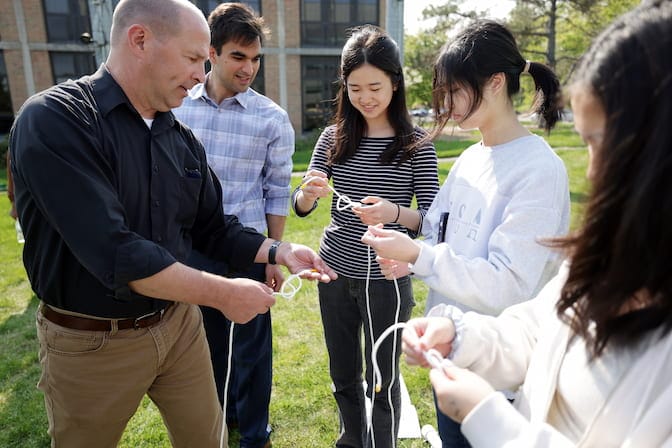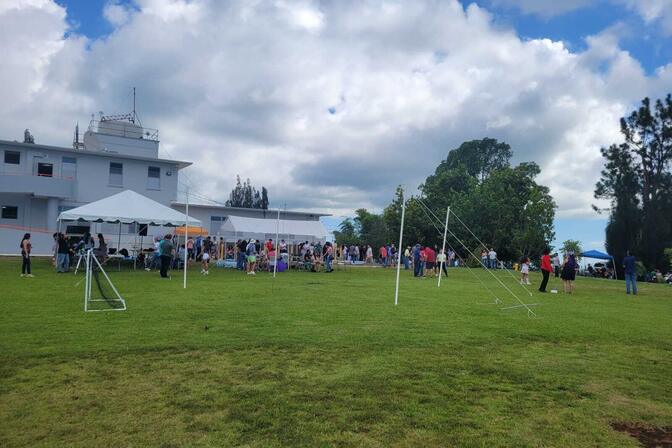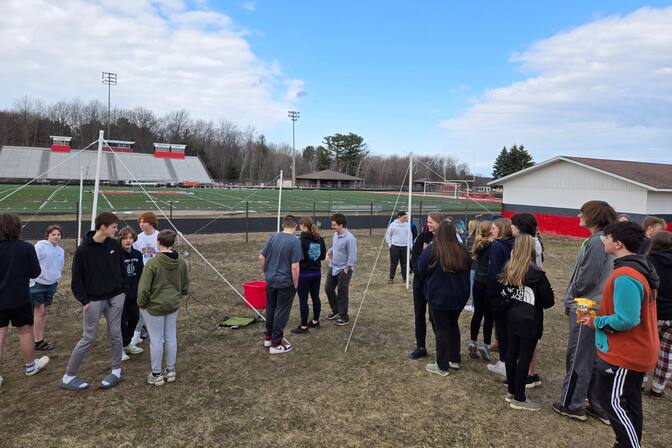
US high schoolers monitor solar storms with an accessible antenna kit
An easy-to-install antenna allows high school students to collect data for NASA, helping improve knowledge of space weather.

An easy-to-install antenna allows high school students to collect data for NASA, helping improve knowledge of space weather.
Experts
Antennas installed at 18 U.S. high schools detected bursts of radio activity that can precede solar disturbances capable of disrupting satellites and power grids on Earth. The observations helped researchers understand solar radio activity and enabled high school students to engage in scientific research, according to a University of Michigan-led study published in Earth and Space Science.
The antennas—developed by University of Michigan undergraduate students as part of a partnership with NASA’s Radio JOVE Project, called SunRISE Ground Radio Lab (GRL)—are packaged as an easy-to-install kit costing just $500. High school students and teachers work together to assemble the antenna and collect data, learning about solar science along the way.
“This project uniquely bridges the gap between complex scientific concepts and accessible education, fulfilling a critical need identified by NASA,” said Mojtaba Akhavan-Tafti, an associate research scientist of climate and space sciences and engineering at U-M and lead author of the study.

While the radio bursts are associated with either solar flares or coronal mass ejections known as CMEs—when the Sun sends out a bubble of plasma and strong magnetic field from its surface into space—this research project focused on CMEs.
A fast traveling CME generates a shock wave that accelerates charged particles like protons and electrons ahead of it. As the high-speed particles travel along magnetic field lines in the plasma, they give off distinctive low frequency radio waves called solar radio bursts.
The ground antennas complement a NASA mission, led by the University of Michigan and managed by the agency’s Jet Propulsion Laboratory. Called Sun Radio Interferometer Space Experiment (SunRISE), it will leverage six toaster-sized satellites to measure and track solar radio bursts.

“Solar radio bursts could be the key to fully understanding how CMEs work and mitigating radiation damage from the flares. Essentially, solar radio bursts would act as an early warning sign of an incoming CME, giving us enough time to shield our electronics and save astronauts from radiation,” said Saul Roman-Ramirez, an electrical engineering undergraduate student at U-M involved in the research project.
![A teenage girl stands smiling in front of an academic poster featuring solar radio burst data.]](https://news.engin.umich.edu/wp-content/uploads/2025/06/Liana-Zhou_Poster-Session-SunRISE.jpg)
The SunRISE GRL dual dipole antenna developed for high school partners operates at 16 to 24 megahertz (MHz)—frequencies that fall between those used for AM and FM radio transmissions—and can monitor emissions from the Sun, Jupiter and the Milky Way Galaxy. The publicly available design includes two copper dipole antennas positioned atop 10 foot PVC pipes set 23 feet apart. The antennas connect to one another and a coaxial cable that goes to a receiver.
“This project offers an exciting opportunity for high school students to become citizen scientists and learn about the Sun and its influence on space weather as well as engage in hands-on experiential learning opportunities in heliophysics,“ said Susan Lepri, a professor of climate and space sciences and engineering at U-M and contributing author of the study.
In April 2024, a dual dipole antenna at a Michigan high school picked up solar radio bursts that were corroborated with solar radio bursts detected by the Peach Mountain Observatory in Dexter, Michigan and the WIND NASA spacecraft, validating the kit design. All three antennas detected the solar radio bursts 48 hours ahead of a large CME.
Students’ analysis of the data from the 18 dual dipole antennas shows solar wind, shock speeds and other parameters that match up with previous scientific studies.
For the 16 observed CMEs, solar radio bursts did not follow a strict timing pattern, with some coming before and others coming after CME arrival. Further investigation into factors like CME velocity, geometry, coronal density or shock formation will help determine what drives those differences in timing.
In addition to collecting valuable data, the project provided hands-on education in space science, radio astronomy and engineering for high school students across the U.S. By engaging with real-world data collection and analysis, students develop critical science, technology, engineering, arts and mathematics (STEAM) skills and gain early exposure to scientific research, potentially inspiring future careers in science and technology.
“The project’s widespread impact was astonishing. Seeing high school students in different areas of the U.S., including Puerto Rico, engage passionately with our antennas during the solar eclipse highlighted the universal appeal and accessibility of our work,” said Akhavan-Tafti.


To promote independent learning and cultivate a deeper understanding of solar phenomena, the Ground Radio Lab developed self-paced training modules.
“During our first year just a couple of students completed the modules. One of those students went on to intern with the U-M SunRISE team during the summer and is a contributor on published work from that internship. This year, participation has increased to 12 students, and is still growing. These modules, along with participation in building the antenna and collecting data, have provided students with a unique, hands-on experience that is not often available,” said Stephen Atwood, a science teacher at Marquette Senior High School in Marquette, Michigan.

At a recent visit to Marquette Senior High School, Akhavan-Tafti gave a seminar to 150 science students. Two students in attendance reflected:
“Listening to Dr. Akhavan-Tafti discuss the process of creating projects like SWIFT, sending satellites into space, was informative and eye-opening,” said Sophia Burkhart, a 9th grader at Marquette Senior High School.
“We fully understood the amount of research effort put into work like this, giving us a taste of what it would be like to work in this field in the future,” added Zeke Miller, another 9th grader at Marquette Senior High School.
This project is ongoing. High schools are encouraged to reach out to the SunRISE Ground Radio Lab to participate. Programs will receive an antenna kit and access to free educational materials as well as an opportunity to participate in monthly interactive webinars with space science and engineering experts.
This research was supported by NASA (AWD006989).